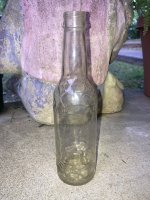cuzcosquirrel
Hero Member
- Aug 20, 2008
- 562
- 133
I think I found a piece of beeswax today. School starts soon, and this was a good way to end it.


I resisted the temptation to carve "67" into it.
I think I also found the base of one of the target towers from when Limantnour was a dive bombing range. Here's a bullet:

I read through the excerpt from Mr. Marx's book and found it interesting. I believe that perhaps because of the choppy weather this year, a lot of stuff is coming up off the bottom. If I get a call from the Point Reyes director, I'm going to give them the information on the stuff I've seen. I got a used copy of Archaeological Evidence of Sebastian Rodriguez Cermeno's California Visit in 1595 by Robert Fleming Heizer today.
Can anyone identifly this for me? I think it may be raw gutta-percha washed up from the wreck.



I resisted the temptation to carve "67" into it.
I think I also found the base of one of the target towers from when Limantnour was a dive bombing range. Here's a bullet:

I read through the excerpt from Mr. Marx's book and found it interesting. I believe that perhaps because of the choppy weather this year, a lot of stuff is coming up off the bottom. If I get a call from the Point Reyes director, I'm going to give them the information on the stuff I've seen. I got a used copy of Archaeological Evidence of Sebastian Rodriguez Cermeno's California Visit in 1595 by Robert Fleming Heizer today.
Can anyone identifly this for me? I think it may be raw gutta-percha washed up from the wreck.








